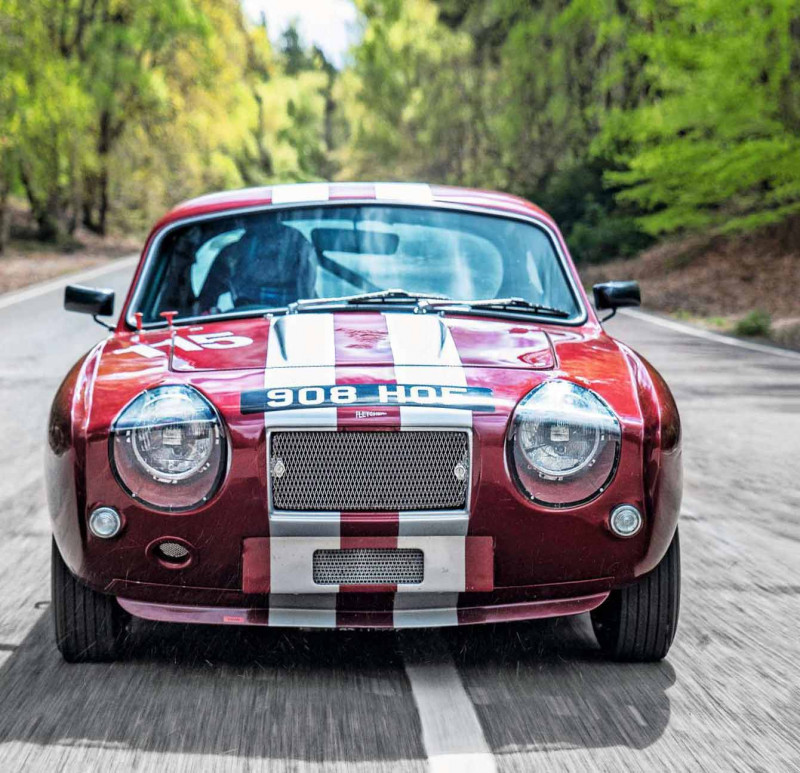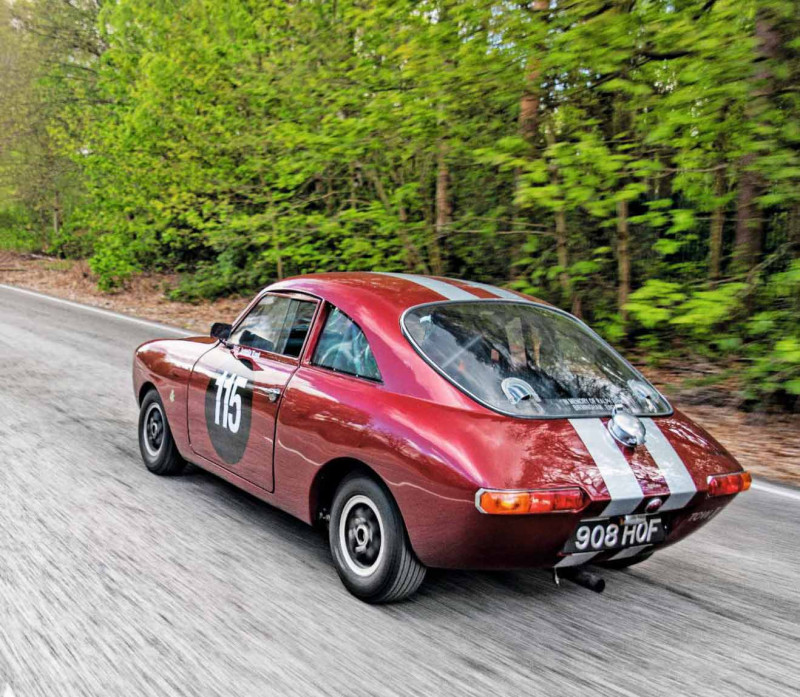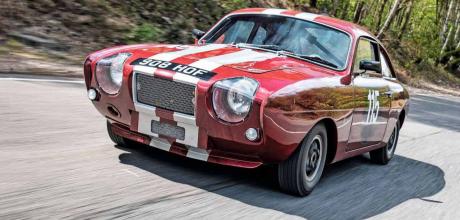1966 Fletcher-Ogle 1300GT
In the Sixties a boatbuilder developed the dormant Ogle GT for racing. We drive the sole Fletcher GT survivor. Words Ivan Ostroff. Photography Neil Fraser.
Flat out in a shapeshifting, identity-changing Ogle Mini built by a speedboat firm
Second Chance
Out for a blast in the 1967 London Racing Car Show Fletcher-Ogle GT
Built in 1966 as a competition-minded show car at the behest of a man more familiar with nautical vessels, the ultra-rare racer I’m approaching today is the sole known surviving Fletcher GT. According to its V5, before it was modified and rebuilt as the Fletcher-Ogle 1300GT, 908 HOF was first registered as a Mini almost sixty years ago in 1963.

The styling of the Fletcher GT’s GRP body is distinctly more aggressive and purposeful than that of the original Mini-based Ogle SX1000 from which it derives. Although it retains Mini running gear on an unaltered Mini floorpan, the car is actually a foot longer than the basis machine. The front end displays a neat, low air dam, the headlamps are covered by perspex fairings, and the fastback rear end treatment looks far more in balance than the SX1000’s rounded rump.
‘That semi-locking front differential simply drags me through the corner
After climbing over the side brace of the full roll cage, I drop myself into the racing seat. The cockpit is snug; clad in drivers suit and helmet I feel like a giant in a Dinky toy. Nevertheless, all-round visibility is good and the view from behind the wheel is barely hindered by the A-posts, which brace a Riley 1.5 windscreen. The interior may be tiny but the main controls are sited perfectly and the full harness has me feeling comfortable and secure. As a Mini, this car would originally have been fully trimmed and fitted with a simple binnacle straight ahead containing the major dials. Its subsequent reincarnation as the Fletcher- Ogle saw it gain extra instruments and warning lamps off to the left. There’s also now a full plumbed-in fire extinguisher system to comply with historic competition regulations.

Being a racer, there’s no passenger seat. In its place is an aluminium box-like structure with various control switches. After appropriate instruction from owner Jonnie Kent, I flick on the master switch then the fuel pump, and after listening to it whirring satisfactorily, I prime the big twin-choke Weber 45DCOE with a couple of sharp prods of my right foot before pushing the sprung starter switch. The 1380cc engine fires with a growl; the exhaust runs underneath the centre of the car and is extremely noisy. With the engine ticking over fast at 1200- 1500rpm, the whole car is alive with a bellowing vibrating resonance. Once the four-cylinder reaches temperature, I depress the heavy clutch and slide the stubby aluminium-topped gear leverinto first gear. The driven front tyres grip instantly, the GT accelerates away well and as I snick the lever back into second, the gearchange feels precise. Weighing just 585kg and developing 132bhp, the Fletcher rockets to 60mph in just six seconds. All four ratios are easy to select and well-spaced; acceleration in second keeps me pinned in my seat. Same in third.
After half a lap of caution, everything seems to be working as it should, so I get a tad bolder. Along the straight, using 7500rpm as a change point, I accelerate all the way up through the gears. Through my helmet I can hear the ZF ’box screaming, while the exhaust blares a thunderously dark metallic bark. At 7500 in top I’m nudging 110mph at which point, approaching another long left hander, I back off. Standing on the brakes, the front discs and rear drums bite well and haul the speed off. I double de-clutch down the dogbox into third and prepare for inherited Mini understeer. Expecting the delicacy of a typical Mini feel, I’m amazed by how much effort is needed to haul the little car as I barrel into the corner. Jonnie did warn me about the effect of the semi-locking differential but it’s still more pronounced than expected. This is like no Mini I’ve experienced before; it possesses a strong desire to continue straight on.
Next corner I know what to expect, so as I approach I brake hard to get the back unseated. This time I clip the apex and pin my foot to the throttle. Jonnie’s advice was good – be a bit brave, hang on in the corners and let that semi-locking front differential simply drag me through and spit me out the other side.
On more open corners I can keep on the power all the way through. Even on the limit there is no sawing at the wheel; the inside front wheel will lift and I lose a bit of traction. But get the entry line right and I can exit the other side well in control. Braking is positive, progressive and very controlled going into corners, and grip from the tiny 5x10 Dunlop CR65s is impressive. With a hard-charging 110lb ft of torque from its eager 1380cc engine, it all helps to make the Fletcher feel like a super-kart. The Fletcher GT’s earliest post-Mini ancestor, the GPR-bodied Ogle SX1000, was conjured up at the premises of David Ogle Ltd in Letchworth, Hertfordshire, and launched in December 1961. The SX used the floorpan, bulkhead, subframes, steering, engine and transmission from a standard Mini donor. After the upper body structure and the original interior trim was discarded, a new Ogle-styled two door coupé bodyshell was bonded in place, then trimmed and refitted to a high standard. The Fletcher GT used the same John Tojeiro-designed square-tube steel spaceframe construction between floor and waist line.
Initially, for a fee of £550, customers could have all of the mechanical components of their donor vehicle re-instated within a new Ogle SX1000 bodyshell; latterly an SX1000 could be ordered from David Ogle Ltd supplied with a fresh Mini Cooper 997cc engine for £1190. Interestingly, Stirling Moss was a nonexecutive director of the Ogle company and owned an Ogle SX himself in which he was filmed when he made a return to Goodwood following his major accident there in 1962.
That year, David Ogle had the idea to produce a Lightweight racing GT version of his car. His prototype had a lighter bodyshell, built-in roll-over bar, lowered suspension and bucket seats. However in May 1962, while driving the sole prototype GT to Brands Hatch, David was involved in an traffic accident which killed him and destroyed the GT. The Ogle company ceased production with just 69 SX1000s completed; today they’re held in high regard within Mini circles and beyond.
Four years later, proprietor of the Fletcher Boats company Norman Fletcher bought the moulds and production rights for the SX1000 from the Ogle family. Fletcher Boats was an established manufacturer of GRP leisure boats such as the popular Fletcher Arrow, but Norman wanted to branch out and manufacture motor cars as an additional revenue stream.
Fletcher’s idea was to evolve the original Ogle GT philosophy, albeit with a new silhouette. He decided that while it should look attractive – subjective indeed – the car must also be lighter and more aerodynamic. During 1966, the company raced a Fletcher-modified Ogle, experimenting with various front and rear ends before finally relaunching the car under the name of the Fletcher GT. The company built four cars, all with slightly different front and rear treatments, before finally settling with the design that he exhibited at the Racing Car Show at Olympia in 1967. And 908 HOF is that very car.
If buyers had already winced at the £550 starting price of the Ogle SX1000 – which was heavier and had fewer seats than the Mini from which it spawned – then Fletcher can’t have been short of conviction. He offered a staircase of engine options – the 850GT at £848, 1000GT at £998 and the 1300GT at £1275 – a decent used E-type cost not much more. Fletcher’s justification came in the form of individual bucket seats, ample sound deadening, a heater and screen washer, a leather-rimmed steering wheel, a fully undersealed chassis and a full array of instruments usually found only in more exotic sporting machinery. Furthermore, he was keen to point out that the car’s box-section chassis was strong and the body was constructed using special marine-specification high-impact-resistant glassfibre. Further modification to engines, gearboxes and suspension was offered at extra cost, up to full race specification. In its 17 February 1967 edition, Autosport reported that, ‘John Rhodes and John Handley will be paired in events next season.
Handley will include long-distance events in the Fletcher GT and his is co-driver is likely to be John Fitzpatrick.’ Owner Jonnie Kent elaborates, ‘According to Paul Stanworth, the previous custodian of 908 HOF, the car enjoyed development by Broadspeed in preparation for Handley to drive in the Targa Florio of May 1967 where it would have been up against cars such as the Mini Marcos, Abarth 1000SP, Abarth-Simca and Sebring Sprite. However a lack of funds meant it did not race. Before he passed away in 2008 Norman Fletcher told previous owner and Fletcher marque expert Paul Ogle (of no relation to David) that when his previously lagging boat sales picked back up in 1967, he moved his interest away from cars and back to the boats because that was his company’s core strength.
Paul Ogle continues, ‘Apart from a programme I have for a race meeting at Cadwell Park in March 1967 showing the entry in the Special GT Car category for the Yorkshire Evening Post Trophy, most of the car’s competition records have been lost over time. During the late Seventies and Eighties however, painted in patriotic red, white and blue, the car did compete in various rallies such as the Wolverhampton and South Staffs Car Club Castrol Rally of 13 October 1979. Driven by Leigh MacLachlan and Nick Doughty carrying number 67, the Fletcher ran in class three and finished third in one section and sixth in another.’
Today though, this car is believed to be the sole Fletcher GT still in existence, save for a scrap body shell spotted in a Midlands breakers yard several years ago. When Jonnie Kent bought 908 HOF, the engine had been rebuilt by Dave Wells of SH Engineering and stroked to 1460cc, producing more than 140bhp. ‘At Spa, following the rebuild, it was able to out-drag a Lotus 26R through Eau Rouge,’ says Jonnie.
However in 2020, it was rebuilt and set up by Nick Swift of Swiftune with the current BMC A-Series 1275 cylinder block, bored out to 1380cc. The crankshaft was also changed for a fresh regular size steel unit, resulting in a smoother and more eagerto- rev unit. The valves were reground, new bearing and piston rings fitted and the engine made fit to race once again.
Perhaps inspired by a previous owner’s decision to repaint the car in Broadspeed’s traditional maroon and silver livery, Jonnie is pondering further revisions. ‘I’m currently considering replacing the engine block again, to get the capacity back to the 1293cc that Broadspeed successfully used back in 1964 so it complies with the sub-1300cc class of many race series, including the Masters.
The tachometer redline is marked at 8200rpm, equating to approximately 120mph in top, which the car attains fairly effortlessly. On a long straight like Lavant at Goodwood for example, Jonnie says that he reaches that speed about halfway along and has to back off to safeguard the engine.
But it’s in the wet that the GT shines. ‘I was recently racing at Oulton Park in the rain with some big rear-wheel-drive machines including Falcons and Mustangs,’ says Jonnie. ‘The Fletcher was all over them, making light work of the lot. It was a real David and Goliath moment, I couldn’t help smiling.’
And that’s all part of the Fletcher’s charm. It may challenge you initially – in both handling and aesthetic terms – but perseverance is rewarded. Jonnie summarises, ‘Once you get used to it, it’s fantastic; a regular Mini just doesn’t have that traction. It’s heavy work fighting the tiller while it pulls through the corners though; racing it can be exhausting. But it can be pedalled around rather rapidly, so when you weigh up the pain and the hard work against the gain it gives in extra speed, it all becomes worthwhile.’ Perhaps the term ‘handling like a boat’ isn’t necessarily a negative one – just so long as it’s one of Fletcher’s.
TECHNICAL DATA 1966 Fletcher-Ogle 1300GT
- Engine 1380cc in-line four-cylinder, ohv, one twin-choke 45DCOE Weber carburetor
- Power and torque 132bhp @ 7800rpm; 110lb ft @ 5300rpm
- Transmission Four-speed manual, front-wheel drive
- Steering Rack and pinion
- Suspension Front: wishbones, Hydrolastic sphere, tie rod. Rear: trailing arm, Hydrolastic sphere
- Brakes Discs front, drums rear, servo-assisted
- Weight 585kg
- Performance 0-60mph: 6.0sec.
- Top speed: 120mph
- Cost new £1275
- Value now approx. £75,000

Unorthodox looks, but the concept certainly works Handling traits define the whole driving experience. Fastback roofline was thought to improve aerodynamics over original Ogle design. Passenger seat removed for historic racing Owner Jonnie has keen historic racing ambitions Huge single Weber almost dwarfs the 1380cc engine.
OWNING A FLETCHER GT
Jonathan Kent has owned the Fletcher now for two years, he also has nine Minis, including a rare original Cooper S. ‘Being a Mini fanatic, I wanted an unusual one, something that was a little bit special. In fact, although I have never taken part in a rally, I had a hankering for a works rally Mini and almost bought one but got pipped at the post. Then I began circuit racing and when I saw the Fletcher I was fascinated by it and its story, so I went for it immediately. Whereas some of the 69 Ogles built have been made into racers, they all started off as road cars. But the Fletcher GT was conceived with racing in mind from the off.
‘This is only my fourth year racing so I’m pleased to finish around midfield, but in the right hands the Fletcher could easily be a podium car. It’s such an unusual little machine, it really deserves to be seen in historic racing like Goodwood. In fact in 2009 the car was part of the display at Goodwood for the Mini 50th Anniversary Celebrations. My ambition is to race it at the Revival or at the Members’ Meeting against other pre-1966 GTs.’


